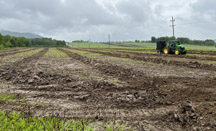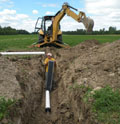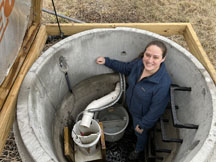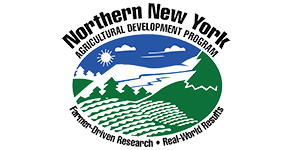
NNYADP Water Quality Research: The Impact of Combined Cropland Management Practices
Project update will be presented to American Societies of Agronomy, Crop Science and Soil Science in November
Peru, New York; October 22, 2024. How do specific cropland management practices impact water quality stewardship on tile-drained farmland? That is a question that newly focused research by the farmer-driven Northern New York Agricultural Development Program (NNYADP) is evaluating. Miner Institute Nutrient Management Researcher Laura Klaiber is conducting research evaluating three different cropping practices to characterize their combined effect on water quality. Field trials are underway on tile-drained land under no-till corn production with a winter cover crop.
Klaiber will present an update on this research at the November 10-13, 2024 join meeting of the American Society of Agronomy, Crop Science Society of America, and Soil Science Society of America in San Antonio, Texas.
 Tile drainage helps support corn production on poorly draining soils. No-till practices over time help improve the soil structure in previously heavily-tilled fields. Cover crops filter surface and ground water, add organic matter to the soil, reduce weeds, and sequester carbon in the soil. Fall-planted cover crops provide a winter covering and can hold nutrients during spring snow melt. The new NNYADP research is collecting data on the combination of these practices.
Tile drainage helps support corn production on poorly draining soils. No-till practices over time help improve the soil structure in previously heavily-tilled fields. Cover crops filter surface and ground water, add organic matter to the soil, reduce weeds, and sequester carbon in the soil. Fall-planted cover crops provide a winter covering and can hold nutrients during spring snow melt. The new NNYADP research is collecting data on the combination of these practices.
“This first phase of the new research in northern New York is looking at whether specific farming practices are achieving the intended environmental quality benefits,” Klaiber says.
The desired benefits reduce the loss of nutrients, such as nitrogen and phosphorus, from tiled fields into nearby waters.
“Our field trials provide the opportunity to compare data sets on nutrient retention and egress from untiled land, previously tiled land, and, now, from previously-untiled land with newly-installed tile,” Klaiber explains.
Working Dairy Farm Hosts Side-by-Side Trials
A working dairy farm in Peru, New York, has hosted tile-drainage research trials since 2016. The side-by-side trials utilize two fields of the same soil type, specifically poorly draining silt loam. Until 2023, one field was tiled, one untiled. Data generated from the field tiled in 2023 will be compared to its own seven-year untiled dataset and to the data from its sister field that was first tiled in 2016. The farmer is applying the same cropping practices to both fields going forward.
The data sets include measures of nitrogen and phosphorus, total surface and subsurface runoff, and total suspended solids as an indication of soil erosion. The data will be correlated with local storm events.
Agronomist Mike Contessa of Champlain Valley Agronomics, Peru, NY, is a project collaborator. Contessa notes, “This research is essential for showing how we can adopt better farming practices while minimizing nutrient loss and improving water management. By closely monitoring how tile drainage, no-till systems, and cover crops work together, we can create more resilient, environmentally-friendly farming systems that benefit both producers and the environment.”

“A broad range of audiences, including agricultural producers, water resource managers, and the public, is interested in learning about how the ways we manage our land influence how nutrients and sediment moves through soil, surface water, and ground water,” Klaiber adds.
The next report on this NNYADP agricultural environmental research will be posted in the spring of 2025 at nnyagdev.org. Previous trial reports are also posted there.
The NNYADP has cover crop variety and breeding selection trials underway to develop a cover crop most well suited to northern climate regions with shorter growing season, harsh winters, and unpredictable weather in the spring planting and fall harvesting windows.

Funding for the Northern New York Agricultural Development Program is supported by the New York State Legislature through the New York State Assembly and administrated by the NYS Department of Agriculture and Markets.